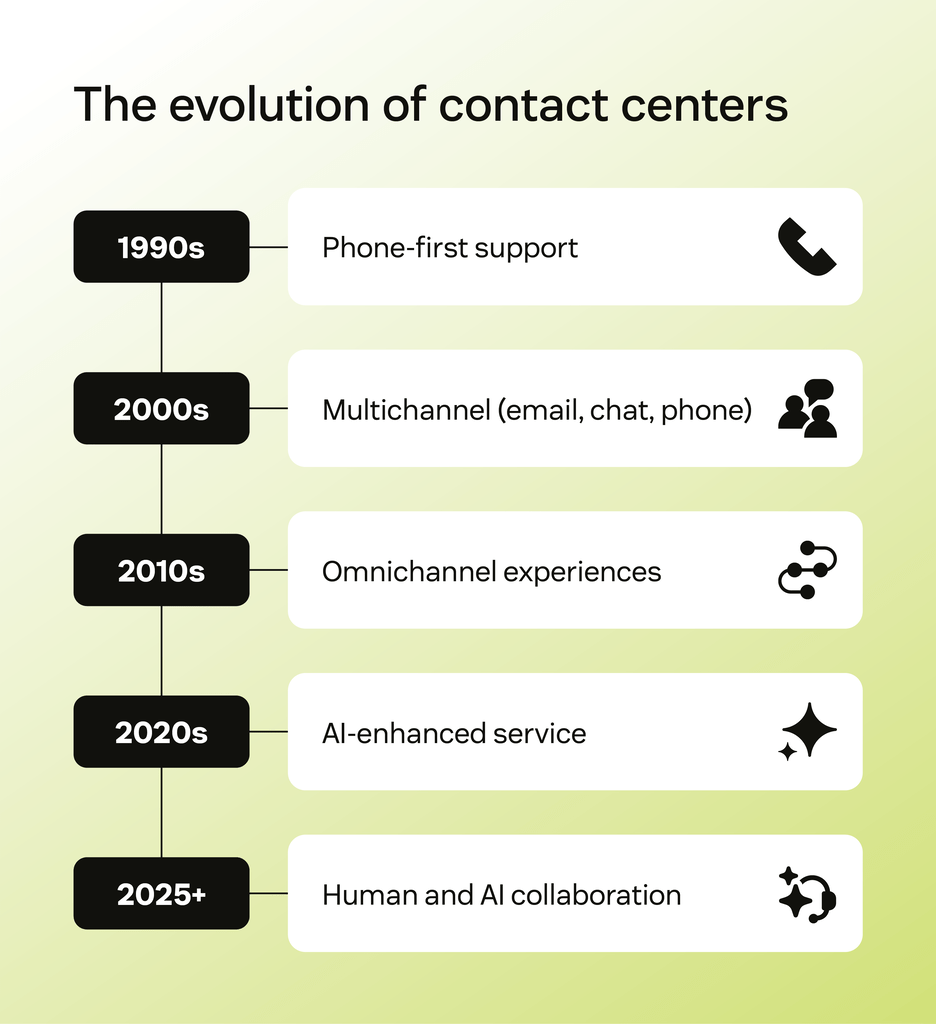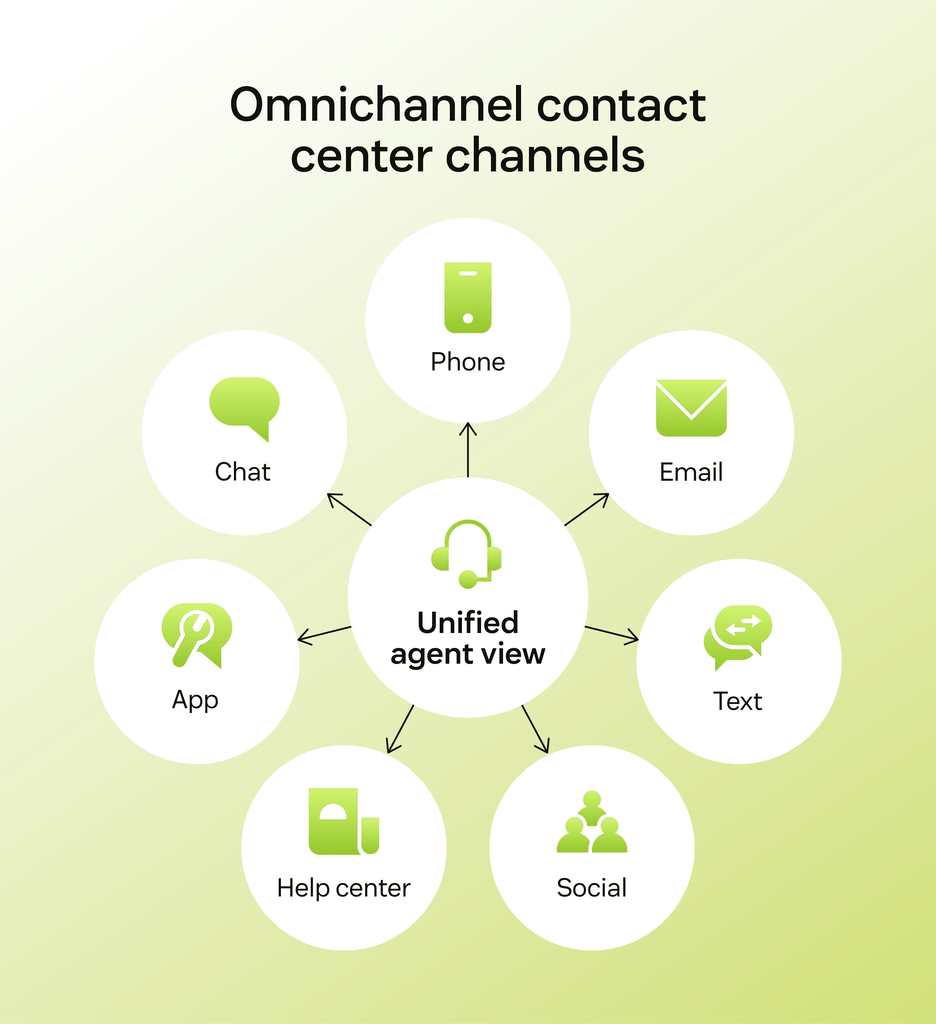Article • 5 min read
6 contact center trends to watch
Learn some of the most important contact center trends to help boost your productivity and CX for this year and beyond.
Última atualização em August 1, 2025
If you’ve needed help with an order recently, chances are you’ve interacted with a contact center. Maybe it was an online chat with an AI agent, a phone call with a customer service rep, or an email follow-up. Behind the scenes, many of the top contact center trends for 2025 are already shaping how these everyday interactions unfold.
As the world becomes more automated and customer expectations rise, contact centers face pressure to become more efficient and personalized. This post explores the most important ways contact centers are changing and what this means for the future of customer service.
More in this guide:
- What is the future of contact centers?
- AI-powered voice is driving more efficient inbound interactions
- AI and automation are creating more efficient support agents
- Omnichannel communication is becoming increasingly important
- AI-powered quality assurance (QA) and workforce management (WFM) are leading to more efficient teams
- Teams need to prioritize data security and privacy
- AI-powered self-service is paving the way for rapid resolutions
- Frequently asked questions
- Bolster your contact center with Zendesk
What is the future of contact centers?

The future of contact centers is closely tied to the rapid advancement of AI. From intelligent routing to real-time agent assist, AI is becoming deeply embedded in how support teams resolve customer issues.
But even as automation becomes more common, people still expect a human touch. In fact, 68 percent of consumers say they’re more likely to trust AI when it feels human-like, according to the Zendesk Customer Experience Trends Report 2025.
As AI takes on more routine tasks, human agents become available to deal with more complex issues. These changes are leading to a future that prioritizes finding a balance between human empathy and AI-driven efficiency.
AI-powered voice is driving more efficient inbound interactions
Among the top contact center trends, many organizations are using voice AI to handle inbound requests in call centers, reducing wait time for customers.
It’s no surprise that 90 percent of CX trendsetters say voice AI is ushering in the next era of customer service. As conversations with AI become more natural and human-like, customers are increasingly open to engaging with voicebots in contact centers.
Even better, with the right contact center integrations, voice tools can also work in sync with Customer Relationship Management (CRM) and ticketing systems to deliver more seamless support.
|
AI and automation are creating more efficient support agents
Next, AI and automation are completely changing the day-to-day for support agents, streamlining their workflows and boosting productivity. Tools like AI copilots and intelligent routing help optimize tasks like ticket prioritization, response drafting, and surfacing relevant context. This allows agents to devote more time to nuanced customer issues that benefit from a human element.
|
Omnichannel communication is becoming increasingly important

Today’s customers are spoiled for choice when contacting support; they can call a support line, start a live chat, fill out a contact form, or even reach out through social media.
Omnichannel contact centers integrate all these channels into a single interface, helping agents better manage conversations while giving customers a more consistent experience.
This unified approach becomes even more powerful when integrated with other key systems, like CRMs. As CRM and contact centers converge, businesses are better equipped to understand customer needs and deliver seamless support across every channel.
|
AI-powered quality assurance (QA) and workforce management (WFM) are leading to more efficient teams
AI-driven quality assurance (QA) and workforce management (WFM) are redefining how contact centers operate behind the scenes. QA in contact centers, which consists of reviewing past support interactions, benefits from AI’s automated scoring capabilities. From there, agents can manually review the more complex cases.
Meanwhile, AI in WFM uses historical data to forecast demand and optimize agent schedules. For example, AI in call center workforce management can analyze call volume patterns to reduce wait times by scheduling more phone agents during high-traffic periods.
Together, these tools refine operations by minimizing repetitive tasks and helping teams stay focused on high-value interactions.
|
Teams need to prioritize data security and privacy
As intelligent contact centersbecome the norm, data security is more critical than ever. AI-powered tools rely on large volumes of personal and financial data, meaning any vulnerability could open the door to misuse or breaches. This makes prioritizing data protection a must for earning customer trust.
Customer data privacy is also a legal obligation; failing to comply with data protection laws can result in serious penalties.
|
AI-powered self-service is paving the way for rapid resolutions
Self-service refers to the various ways customers can solve issues independently, such as using knowledge bases or chatbots. One way AI improves these resources is by refining search and content suggestions in help centers. It also powers chatbots that can guide customers through multi-step tasks independently.
These AI enhancements make self-service more efficient, helping customers find what they need quickly without always needing to escalate to a live agent.
|
Frequently asked questions
Customer story


BAUHAUS
BAUHAUS + Zendesk: the power of WhatsApp
"We found the Zendesk solution to be very easy to use. It offers lots of information we need to optimize our everyday work and provide a better customer experience."
Bea Niewiara
Contact Center Manager
Bolster your contact center with Zendesk
All in all, contact centers today face the challenge of providing quick resolutions while maintaining the human touch that customers still expect. AI is integral to achieving this by empowering support agents to work with tools that speed up routine tasks and strengthen decision-making.
Businesses need to embrace these top contact center trends to keep pace with rising customer expectations. Zendesk for contact center is built for forward-thinking teams ready to move beyond the limitations of traditional models. It’s a solution built for today’s challenges and how customer support will continue to evolve.
